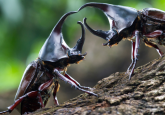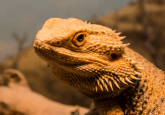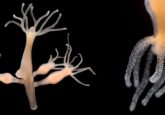How evolutionary biologists calibrate a molecular clock

By combining genetic analysis of present-day animal species with age estimates for fossils of ancestral species, scientists have determined that divergence of major animal groups occurred early and more rapidly than previously thought.

Artistic rendering of progressive glaciation leading to a “Snowball Earth.” Credit: NASA.
Kingdom Animalia–which includes you, me, and a vast array of creatures from sea sponges to monkeys, all descended from a common ancestor–is hundreds of millions of years old. When and how the major animal phyla emerged during evolution has been the subject of much research and speculation.
Now, researchers Martin Dohrmann and Gert Wörheide at Ludwig-Maximilians-Universitaet (LMU) in Munich have produced one of the most comprehensive models to date of early animal evolutionary divergence (1). “Our study is based on a combination of genetic data from contemporary animals and information derived from well-dated fossils, which we analyzed with the help of complex computer algorithms,” said Dohrmann.
Without access to the genomes of our most distant ancestors, scientists have turned to molecular clock studies to produce models of phylogenetic relationships between related clades, phyla, and species, both living and extinct; these include estimates (on the scale of hundreds of millions of year) for when these species diverged. The models are based primarily on comparative mutation analysis of common genes/proteins from existing species, with time estimates depending on the degree of sequence divergence and estimated rate of molecular evolution, among other variables.
To build their evolutionary models, Dohrmann and Wörheide used a previously published phylogenomic data set containing sequences for 128 different proteins from a broad range of bilaterian (possessing both head/tail and front/back symmetry) and non-bilaterian animals. They then created models using different fossil calibration sets, which contain the ages (calibrations) of the oldest known fossil for different ancient species. These calibrations are used in molecular clock studies as estimates of the latest possible date for a species’ divergence from its relatives.
The authors wrote that they achieved the most “plausible and precise results” with the largest fossil calibration set they tested. The model produced using those calibrations confirmed previous estimates that animals originated during the early-mid Neoproterozoic era (720–1000 million years ago), and that the emergence of early clades and phyla, including the splitting off of bilaterians from non-bilaterians happed over a relatively short span, evolutionarily speaking, of 50 million years.
“In addition, this early phase of evolutionary divergence appears to have preceded the extreme climate changes that led to Snowball Earth, a period marked by severe long-term global glaciation that lasted from about 720 to 635 million years ago,” Dohrmann said.
For future studies, Dohrmann and Wörheide plan to refine these models by adding more data and improving the statistical methods used. To this end, the identification and dating of more ancient animal fossils is something they hope for. “To arrive at well-founded conclusions with respect to the morphology and ecology of the earliest animals, we also need to know more about the environmental conditions that prevailed during the Neoproterozoic, and we need more fossils that can be confidently assigned to specific taxonomic groups,” explained Wörheide.





